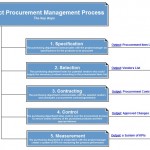
Project Procurement Process
a Project Procurement Process [also called “Project Procurement Management Process”] is a method for establishing relationships between an organization’s purchasing department and external suppliers to order, receive, review and approve all the procurement items necessary for project execution. The supplier relationships are managed on a contractual basis. The process aims to ensure timely delivery of the purchased items which are selected and acquired according to the specifications and requirements set up by the purchasing department and approved by the project manager.
The procurement process includes five major steps, as follows:
- Specification. This step involves the purchasing department in communicating with the project manager to develop and approve a list of procurement items necessary for project implementation. The department must specify the approved items to external vendors.
- Selection. This step of the project procurement process requires the department to find potential suppliers which can procure the necessary items, according to the specifications. For this purpose the department needs to set vendor selection criteria, which may include such measures as Delivery, Service Quality, Cost, and Part Performance.
- Contracting. The department must communicate with the suppliers on delivery dates and payment conditions in order to ensure “on-time” delivery of the ordered items within the stated project budget. All the conditions should be listed in a procurement contract. Also a detailed delivery schedule should be negotiated with the procurers and approved by the purchasing department.
- Control. Success of the procurement management process depends on how the purchasing department controls the delivery and payment processes. Through arranging regular meetings with the vendors, tracking delivery progress, reviewing the ordered items against the approved product specifications, and making necessary changes to the procurement contract, the department can control the process and ensure successful accomplishment.
- Measurement. The final step of the project procurement management process refers to using a system of performance indicators and measures for assessing the effectiveness and success of the entire process. The project manager needs to set up such a system and the purchasing department needs to use it in measuring the process. Special meetings and workshops can be conducted to view KPIs, intermediate results of staged delivery, performance of procurers, adherence to product specifications, communications with suppliers, and the like. In case any deviations or gaps are revealed the department should notify the project manager and make necessary changes to the procurement plan.
Project Procurement Plan
Planning of project procurements is carried out within the procurement process and results in developing a plan. A procurement plan is a convenient tool for organizing and managing activities and tasks related to the procurement management process. A template of the plan is to be designed by the purchasing department in cooperation with the project manager. A project procurement plan should be reviewed and approved by the project manager before any supplier relationships get started.
A project procurement plan template documents:
- Deliverables to be procured by proposed agreements/contracts.
- Effective resource management strategies for negotiating and managing the agreements/contracts.
- The need for staged delivery and desirability of testing the procured items before introducing them into the implementation process (this item is optional).
- The chosen procurement method (payments, expressions of interest, request for price/quote, request for tender).
- Key stages of the process for selecting suppliers and vendors.
- The model of procurement funding.
- The sample of procurement contract/agreement.
- References to quality approvals, quality assurance and risk management.